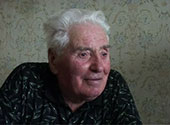
Arkadii Gelman was born in 1921 in Kamyanets-Podilskyy. His father, also born in Kamyanets-Podilskyy, was a locksmith and his mother, who was born in Kitaygorod, was a homemaker. He had three siblings: two brothers and one sister. Before the war, he went to a Yiddish school and worked together with his father as a locksmith. He served in the Red Army during the Second World War, and fought in the Battle of Berlin. After the war, he worked as a cattle dealer.
Other Interviews:
Sabbath and PovertyChallah
Craftsmen and Merchants
Kamyanets-Podilskyy, Ukraine
Jews in the prewar Soviet Union often worked in traditional handicrafts, as they had for generations. According to the 1926 census, Jews constituted 74 percent of all artisans in Tulchyn and 69 percent of all artisans in Vinnytsya district. Many Jews dabbled in multiple jobs, buying, selling, and making whatever they could manage. About one-third of all Jews worked in the occupations that the Soviet government targeted for elimination—trade and traditional handicrafts
Indeed, practicing traditional crafts was not a generally efficient way to earn a living; a craftsman had to be able to sell his or her wares as well. In this clip, Arkadii Gelman, who made his living as a cattle dealer in Kamyanets- Podilskyy, explains how artisans would buy and sell their wares to eke out a living.
Source: Jeffrey Veidlinger, In the Shadow of the Shtetl: Small-Town Jewish Life in Soviet Ukraine (Indiana University Press, 2013)
